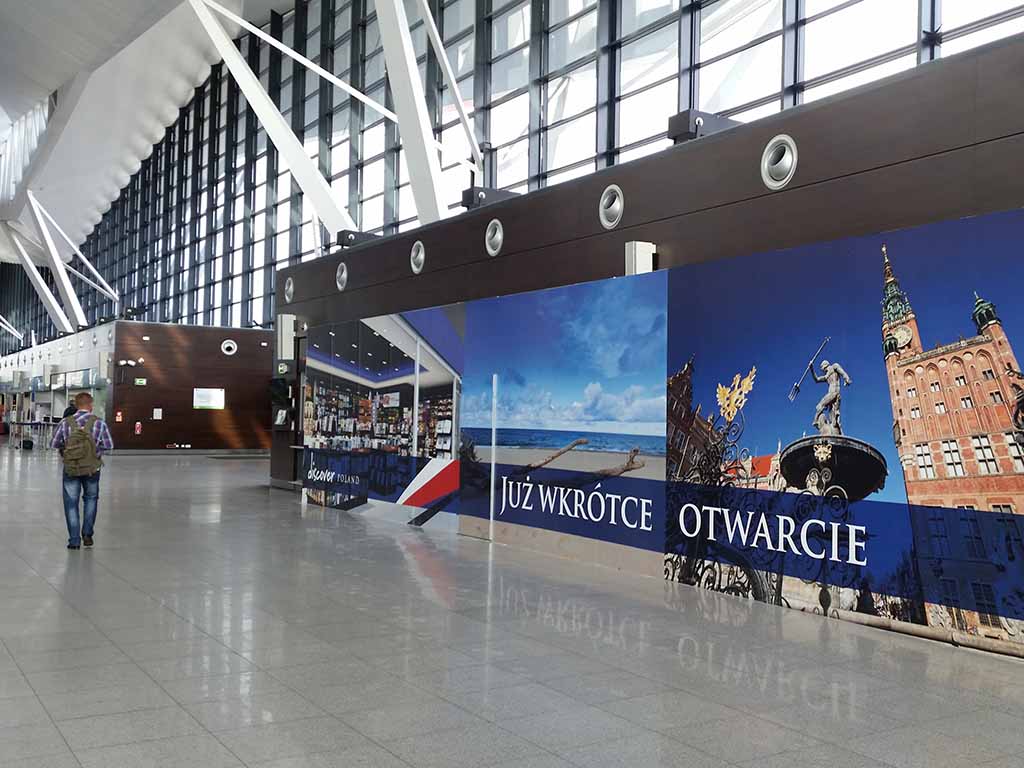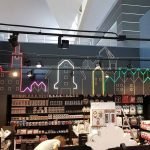graphics on shopfront hoardings
It can be called differently: temporary construction, temporary wall, renovation wall, masking wall, shopfront hoarding. Renovation of premises located in a closed public space, in particular in shopping centres, often means the need to erect a temporary building wall made of plasterboard or OSB. To improve the aesthetics of the place and build relationships with the recipient, such spaces are often covered with graphics on shopfront hoardings
functions of graphics on temporary constructions
Graphics on shopfront hoardings can serve many functions during construction or renovation.
- First and foremost, they provide aesthetic separation, obscuring the workspace from the shop window, which is crucial in high-traffic areas such as shopping centres, public transport hubs, train stations, or airports. This allows work to be carried out without disrupting the aesthetics of the surrounding area and without the need to obscure windows with films or curtains.
- The second function of graphics on shopfront hoardings is their decorative value. Instead of a stark, temporary structure, customers see a well-thought-out, aesthetically pleasing graphic composition that visually organises the space and alleviates the chaos of renovation. This prevents the shop from appearing closed due to damage or neglect – on the contrary, it creates the impression of a place that will soon offer something new and interesting.
- The third important function of such graphics is the ability to visually communicate with customers before the opening. This allows them to announce a planned opening, a developing brand, investment partners, or a promoted offer. In the case of chains – such as pharmacies, FMCG stores, or fashion brands – these graphics help maintain a consistent visual identity and strengthen the brand’s presence at the local level.
- Finally, temporary walls have significant advertising potential. Even when the location is closed to customers, the space within its window can enhance brand recognition and build excitement before the opening. Skillfully designed graphics attract attention, generate interest, and can convey key information – such as the opening date, the character of the future tenant, marketing slogans, logos, visual identity elements, or product designs. In the case of new locations of well-known retail, restaurant, or service chains, such messages reinforce the message of the image campaign and allow the brand to be firmly established in the minds of consumers even before the launch. In the case of new brands, well-designed graphics can intrigue, arouse curiosity, and encourage people to stay informed about the upcoming opening. This allows the space, which is usually neutral, to be fully utilised as an effective marketing tool. Crucially, premises that are unused for extended periods can also be obscured by advertising from other tenants with premises in the same space.
Wrapping dry walls. Wrapping renovation walls.
Depending on the material used for the wall construction, as well as the length of the planned renovation and budget, it is possible to use different printed substrates. BBS billboard paper: glued in the same way as posters on advertising media – an economic solution used in conjunction with primed surfaces; matt self-adhesive films: a common and inexpensive solution where wall material is of secondary importance. The matte finish of the film partially masks any possible imperfections of the wall; frontlit banner material: best for uneven wall surfaces and wherever it is advisable to hide temporary entrances to the premises.
In the photo: Graphics on the wall during the shop renovation – printing on self-adhesive film Poland, applying film on plasterboard. Shop window wrapping Poland. Plasterboard wall covering. Advertising graphics on the wall. Advertisement during renovation. Wrapping premises in a shopping centre.


